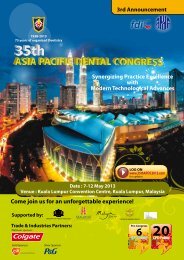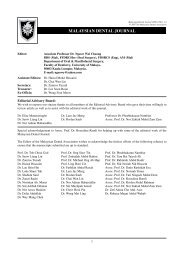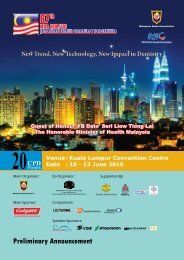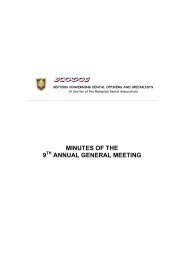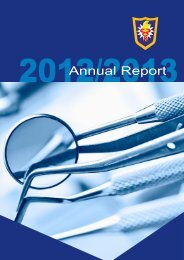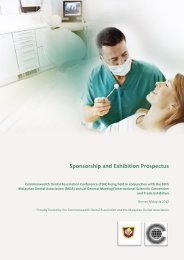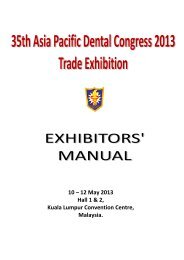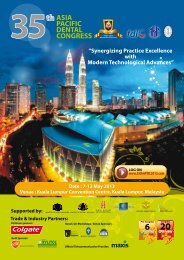PDF( 8mb) - Malaysian Dental Association
PDF( 8mb) - Malaysian Dental Association
PDF( 8mb) - Malaysian Dental Association
Create successful ePaper yourself
Turn your PDF publications into a flip-book with our unique Google optimized e-Paper software.
MALAYSIAN DENTAL JOURNAL<strong>Malaysian</strong> <strong>Dental</strong> Journal (2008) 29(2) 119-127© 2008 The <strong>Malaysian</strong> <strong>Dental</strong> <strong>Association</strong>The Reliability Of Bitemark Evidence: Analysis And Recommendations In TheContext Of <strong>Malaysian</strong> Criminal Justice SystemShamsher Singh, LL.B, CCA, M.CJ, School of Social Sciences, Science University of Malaysia, Penang, Malaysia.Phrabhakaran Nambiar, BDS, B.Sc Dent., M.Sc Dent., M.Sc Dent., PGDip. Dent. Professor, Department of General<strong>Dental</strong> Practice and Oral & Maxillofacial Imaging, Faculty of Dentistry, University of Malaya, Malaysia.ABSTRACTForensic odontological examination of a disputed bitemark can furnish the police and the prosecutor withuseful evidence to either implicate or exonerate a person in relation to a crime, on the basis that each person’sbitemark is as distinctive as his or her dentition. The aims of this article are (a) to evaluate the extent of whichbitemark evidence is reliable as a proof of identification of a biter for the purposes of criminal investigation andprosecution in Malaysia and (b) to make the necessary recommendations (if any) for the purpose of improvingthe reliability of such evidence. Where a questioned bitemark is not sufficiently detailed, any findings made fromits examination shall be highly unreliable and prejudicial. On the other hand, where a bitemark is sufficientlydetailed, then any findings made from its examination may be reliable, provided that the forensic odontologistsand other practitioners in the criminal justice system are professionally trained to handle the said bitemark.Therefore, police officers must be given a basic training in the field of forensic odontology so that they will be ableto appreciate the evidential value of bitemark and contribute to the development of bitemark cases in Malaysia.The relevant authorities governing the dental practice in Malaysia should standardize the methodology andterminology used in bitemark examination and in the reporting of its findings so that confusion and inconsistencyamong the forensic odontologists are kept absolutely low. Finally, forensic odontologists must be given specializedtraining in bitemark examination so that the probative value of their findings can be improved.IntroductionThe American Board of Forensic Odontology(ABFO) defines a bitemark as (i) a representative patternleft in an object or tissue by the dental structures of ananimal or human and (ii) a physical alteration in a mediumcaused by the contact of teeth. 1 MacDonald propoundedthat any mark produced by teeth, in combination withother oral parts like the lips and tongue, also falls withinthe definition of a bitemark. 2 However, in this article, theword “bitemark” shall be understood as a representativepattern produced by the anterior teeth of a human biter onthe surface of any bitten substance, and the meaning of theword “bitemarks” shall be construed accordingly.At the scene of a crime, bitemarks are usually foundon the body of physically-abused or sexually-assaultedvictims, on any unfinished food like cheese, apple ordiscarded chewing gums, or on any other inanimate objectslike pencil or duct tapes. 3,4 In some cases, bitemarks canalso be inflicted by a victim on the assailant’s body in selfdefence.Moreover, some bitemarks may be self-inflicted,especially in those cases where there are false allegationsof rape or abuse, while others may be inflicted as a resultof mutual consent between the parties. 5The forensic value of bitemarks is that they can beused either to implicate or to exonerate a person, in relationto a crime. 6 This is possible based on the postulates thatdental characteristics of the anterior teeth are distinctiveamong the individuals and this asserted distinctivenesscan be transferred and recorded in the form of a bitemark 7(Figs. 1 and 2). In short, a bitemark is the mirror-image ofthe dentition of a biter and it follows that where a disputedbitemark matches (or does not match) with the dentalfeatures of a person, then that person, within the reasonablemedical/dental certainty, is (or is not) the biter. For thisreason, it is often stated that a person may lie through histeeth but the teeth themselves do not lie. 7Be that as it may, the reliability of bitemark evidenceas a proof of identification of a biter (where the identity ofthe said biter is both relevant and in contention) has to beestablished in the court of law before such evidence can berelied upon. Justice Paul (as his Lordship then was) statedthat trial judges must warn themselves as to the dangers ofconvicting accused persons based on any evidence, where119



